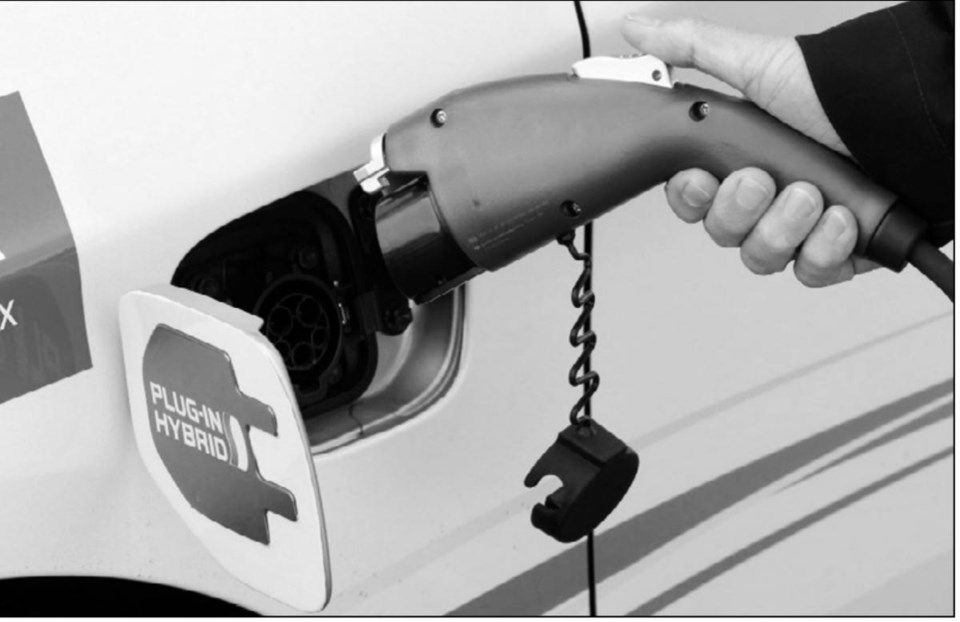Some people claim they can see into the future. Today, I'm driving it. It's a car that was actually built two years ago, but has yet to appear in showrooms.
The 2010 Toyota Prius Plug-In Hybrid (PIH) is an ordinary Prius with a larger battery that can be recharged just like an electric vehicle.
Toyota created 500 of these cars strictly for testing and sent them to markets around the world. Canada got a fleet of five, including this one. These evaluation cars were typically loaned to utility companies, such as B.C. Hydro, and educational institutions for engineers to prod and poke at. Now, at the end of their test period, it's journalists' turn.
Apart from the "look at me" wrap adorning the car, it looks like a typical Prius. The only giveaway is a fuel door just ahead of the driver's door and a larger-thanusual spoiler on the rear hatch.
While Toyota has not set an official release date, the best bet of seeing one of these in a showroom is fall or winter of this year.
The PIH is a logical evolution of the Prius, a combination of the latest in hybrid and electric vehicle (EV) technology. It relieves drivers of the range anxiety normally associated with EVs.
The major difference between a typical Prius and the PIH is the battery. The regular car has a 1.5-kWh (kilowatt-hour) nickel metal hydride battery. The Prius PIH has a six-kWh lithiumion battery. This larger battery gives the PIH an electric-only range of about 22 kilometres. Once it's depleted, the Prius PIH reverts back to hybrid mode.
Otherwise, the powertrain is exactly the same: A 1.8-litre four cylinder Atkinson Cycle engine with 134 net horsepower mated to a continuously variable transmission.
The larger battery allows the Prius to travel at up to 100 km/h on EV mode. On a regular Prius, electric-only power is available solely from a stop up to about 20 km/h.
In theory, a driver can drive on EV mode alone and not use any gas in the PIH. In practice, that proved hard to achieve.
It seems simple enough - keep a light foot on the accelerator. I was able to get zero gas consumption on a number of short trips.
But life's not always that simple. Sometimes, to keep up with traffic, you have to depress the accelerator a wee bit harder. As soon as the power gauge enters the "Power" sector, the gas engine cuts in. But it doesn't automatically shut off - it runs for about a minute.
EVs work harder on hills. If you have hills on your route, it will drain the battery quickly. With just a six-kWh battery, a driver can watch the gauge that measures battery capacity click down by the second.
Merging on the highway requires more power, with the motor cutting in with a groan.
The Prius has a memory, keeping track of how frugally one drives. In my week with the Prius PIH, my best trip was zero usage. Overall, in 120 km of city driving, my average fuel consumption was 1.7 litres/100 km at an average speed of 27 km/h.
One 26-km trip on the highway depleted the battery completely, so at the end, I was driving on straight hybrid mode. On that trip, the motor actually came on a few times as the battery registered about two kilometres left.
The fully depleted battery took 1 1 /2 hours to fully charge, using my 220-volt Level 2 charger. It can also be charged in three hours using a cable plugged into a regular home power outlet.
The interior of the PIH was identical to a regular Prius. The only differences are in the vehicle's information display.
There are five information screens to choose from:
? The five-minute interval screen gives energy usage every five minutes for up to 30 minutes
? Past Record gives fuel-used information on the last five times the reset button was pressed on Trip A or B
? Driving ratio shows percentage of time EV and hybrid were used
? Energy Monitor is a pictogram that shows which power source (gas engine or electric motor) is being used and battery level. This is also found in the regular Prius
? Hybrid System Indicator shows battery level in kilometres left on EV and a sliding graph showing (from left to right) when the battery is being charged by regenerative braking, regular driving and peak power demand. A subset information line shows total Trip A (or B) elapsed distance, average fuel consumption and average speed.
Our tester had a navigation system. The screen was of low resolution and there was no back-up camera tied with the system.
Our tester was a prototype, so I don't know if they will keep the battery charger under the passenger seat.
The only other feature is a pre-heat and pre-cool feature, which only works when the vehicle is plugged into a house outlet. The idea is that an owner will engage either when the weather is in either extreme. With the car cooled or warmed to a comfortable level before a drive, a driver won't need to engage the car's heater or air-conditioning system, which are notorious power hogs.
The Prius PIH's main competitor will be the Chevrolet Volt. The two vehicles are similar in that they have a battery and the ability to travel on just EV mode. What's different is what happens once the battery is depleted. The Prius just reverts to hybrid mode. The Volt engages its auxiliary engine, then recharges the battery.
Keep in mind this review is done on a two-year-old prototype. But I wager the eventual car won't be much different. If so, it will join the growing Prius family, which now includes the Prius V, a mini-minivan, and the Prius C, a sub-compact, along with the regular Prius.
The PIH also lays the groundwork for an all-electric offering from Toyota in the foreseeable future.



